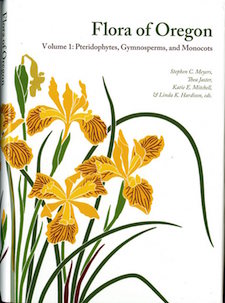Flora of Oregon, Volume 1:Pteridophytes, Gymnosperms, and Monocots.
Last Updated on November 21, 2022 by

by Stephen C. Myers, Thea Jaster, Katie Mitchell, and Linda K. Hardison, editors.
ISBN 978-1-889878-46-1
Botanical Research Institute of Texas, Fort Worth, Texas., 2015
Contemporary, authoritative, comprehensive, well-illustrated, beautifully laid-out, and easy-to-use. These terms aptly describe Flora of Oregon, Volume 1: Pteridophytes, Gymnosperms, and Monocots, which was published in 2015. The impacts of this book reach well beyond the Oregon borders because many of the plant taxa (species, subspecies, and varieties) spill over into adjacent Washington, Idaho, and Nevada. Botanists in those areas now have a new fern, conifer, and monocot flora too!
The Oregon Flora Project (OFP) was initiated in 1994 by the late Dr. Scott Sundberg, who died much too young in 2004. Dr. Linda Hardison, who was married to Scott, continued the project after his death, assuming the role of Director in 2005. Over the next 10 years, under Linda’s guidance, the OFP assembled a team of botanists to serve as editors (Dr. Stephen Meyers, Thea Jaster, Katie Mitchell) and artistic directors (John Myers and Tanya Harvey). This team brought together the keys, plant descriptions, and illustrations from numerous authors that included team members themselves and other outstanding botanists from throughout Oregon and across North America.
The introductory section of this volume recognizes contemporary botanists who have been major drivers behind the Oregon Flora Project, as well as historic botanists whose work provided the foundation for this effort. Flora of Oregon will ultimately comprise three volumes, and I’m pleased to report that great progress is being made on the remaining two.
Don’t try to quickly skim through the introductory sections: they contain a wealth of vital statistics about Oregon’s flora. In addition to the botanist biographies mentioned above, there are excellent descriptions of the diverse ecoregions found across Oregon. These are accompanied by dozens of photographs that will make you start a list of places to go (a list of 50 such destinations is provided, but you’ll certainly want to add others). These 65 pages contain such a wealth of background information that you’ll feel like you’re getting a free book along with your flora.
As the title suggests, the volume is divided into three sections (ferns, gymnosperms, and monocots). Within each section is a key to families, within families there are keys to genera, and within each genus there is a key to species followed by full descriptions of each species. When species have infraspecific taxa (i.e., subspecies or varieties), keys are provided after the species description. Descriptions for each family and genus are also provided.
Users will enjoy the consistent structure of the family, genus, and species descriptions. Important morphological characters are in bold (e.g., roots, leaves, flowers), allowing easy comparisons among taxa at the same rank (e.g., species vs. species or genus vs. genus). Every species description is accompanied by a list of synonyms where relevant, common names, and a map of where the species (or subspecies or variety) occurs in Oregon. The maps use a combination of shading (to show general areas covered) and dots (to represent precise locations of collections). I am particularly fond of this feature because geographic location can be very informative in terms of deciding what to call the plant in your hand or at your feet.
The keys and descriptions run about 450 pages in length, covering 1,054 taxa. These are followed by a glossary and an extensive list of references. There are also appendices addressing endemic taxa, rare plants, taxa not treated in the book, and other topics. The index, perhaps the most used section of any flora, is extremely well presented and organized. If nothing else, and there is plenty more, the font is clearly legible and doesn’t require magnification to read. Altogether the page count comes to 592, which is an impressive number because the book looks and feels lighter than most volumes that size.
My only wish is that all of the species in the book were illustrated, and this should be interpreted as a wish and not a criticism. Precious few floras are fully illustrated due to the time and cost involved. Here, at least one species of each genus is illustrated, and for those genera with four or more species, generally 25% of the species are drawn. Principal Illustrator John Myers did many new drawings for the volume, and they are outstanding, as is Tanya Harvey’s overall layout and design.
Flora of Oregon, Volume 1: Pteridophytes, Gymnosperms, and Monocots should be on your shelf. It contains the most contemporary taxonomic framework for our region’s plant families and genera, making it an excellent systematics resource for botanists at all levels. Easy to use and well-written keys, botanical history, and insights into the ecology, geology, and geography of Oregon make for a book that you will not outgrow and in some ways will never go out of date. You’ll find plenty more between the covers than what I’ve written about here, more than enough to make botanists in neighboring states envious of Oregon botanists’ good fortune in a new Flora.
—David Giblin, University of Washington Herbarium, Burke Museum.
Adapted from a review originally published in Washington Native Plant Society’s Spring 2016 issue of Douglasia.
